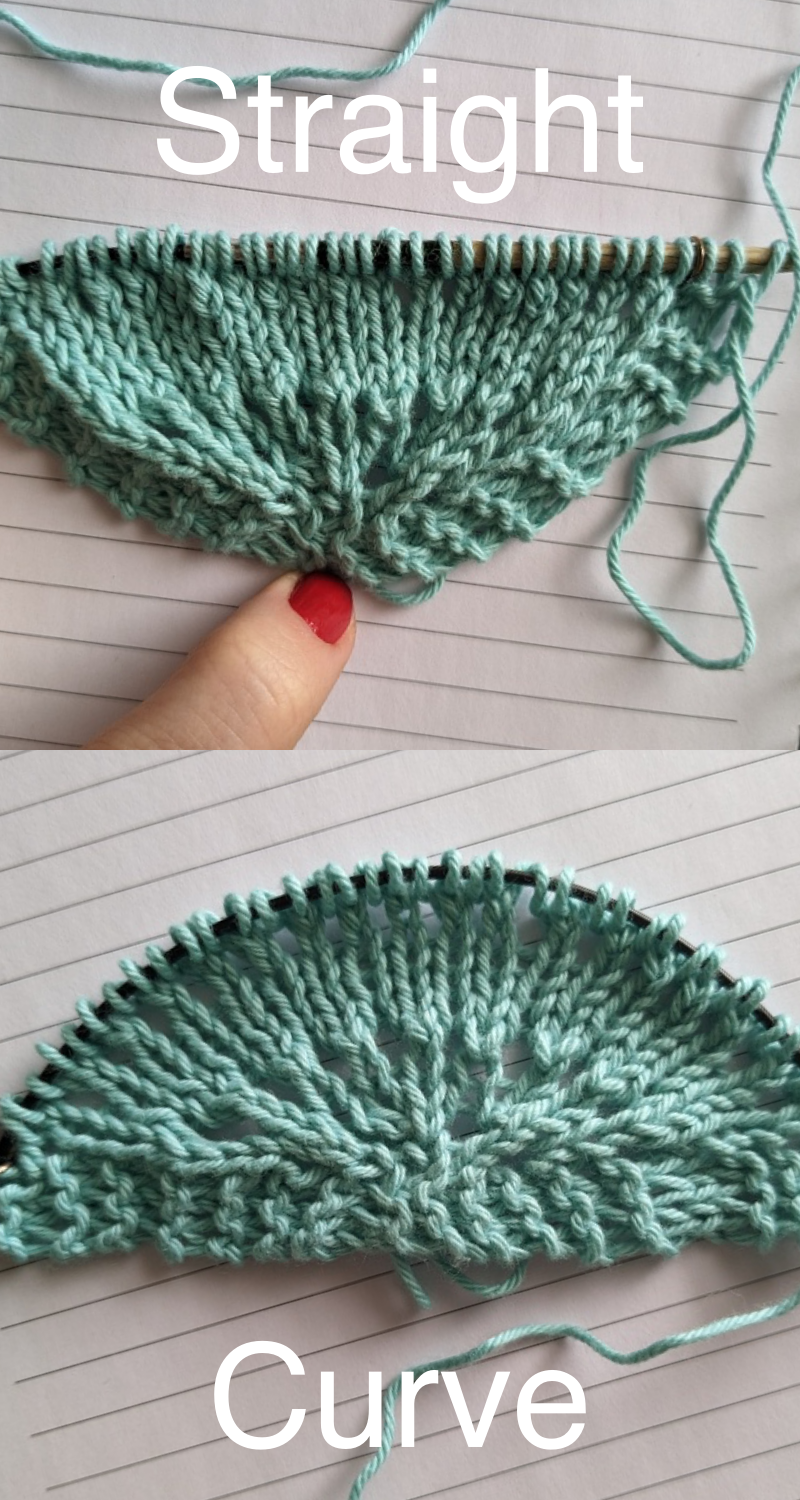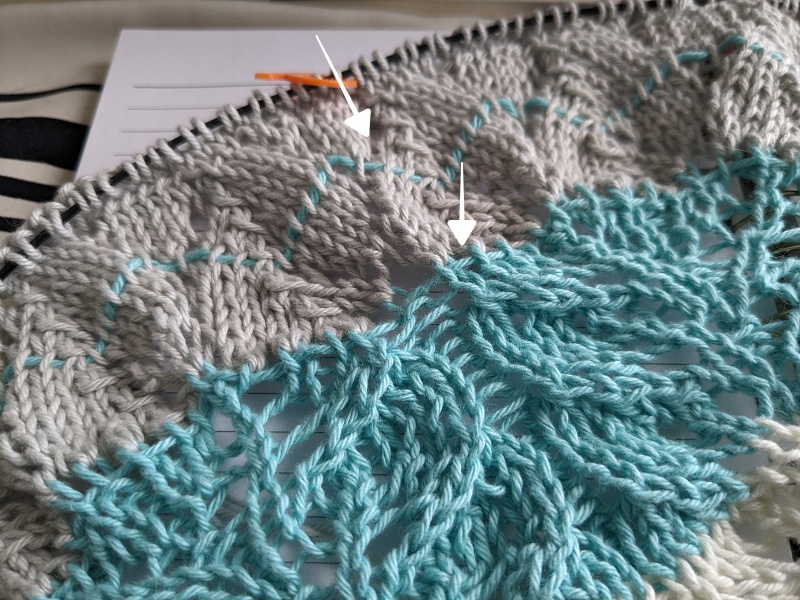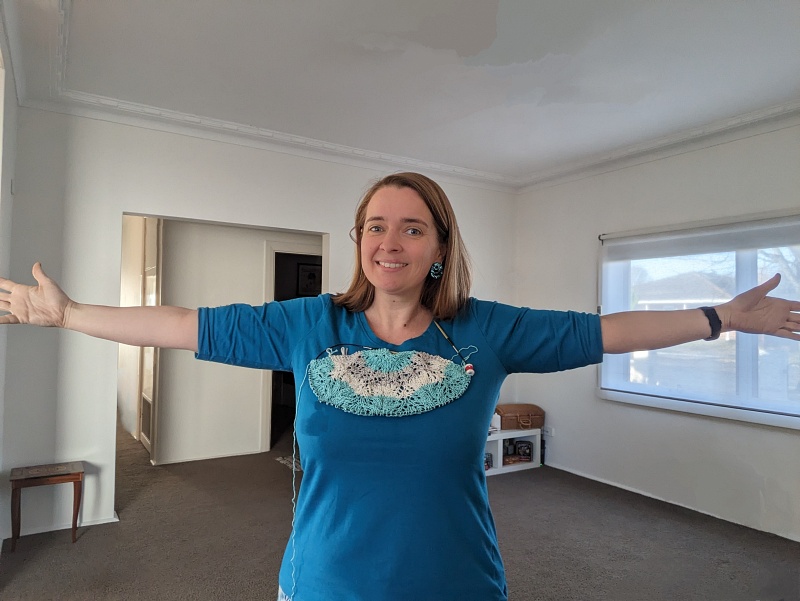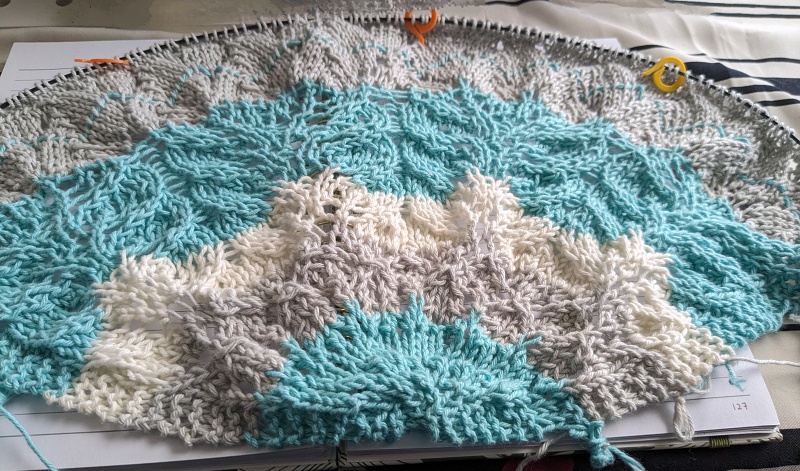Big projects always mean challenges
- Learning new skills
- Commitments
- Time & effort
- Motivation
So far this project has ticked three of those. The motivation factor is still pretty high so I’ve not had that challenge yet, but I’m certain it will come in time.
But it all started with a garter tab cast on. Which makes for some interesting straight versus curved play. 
Eventually, this is going to be 293 stitches wide, and there is a knit on border that takes about 15 rows to cast off a single stitch. The pattern says repeat x 585 rows! Mammoth is the only word I could find to accurately sum up this project.
In terms of learning, I thought I’d share a couple of the 'methods' I’ve adopted. I’m not sure if these are common methods that I haven’t realised I’ve learned or if I’m being creative with what works for me. But I thought other knitters might just find them useful.
The Fall Back Row 
I’ve pulled out this pattern three times in total so far. And because of the lace once you start pulling it can be pretty tricky to pick up stitches. The section that has been problematic is 150 stitches wide, with a yarn over every 5 stitches or so, unpicking each stick across multiple rows is just too much effort.
I’ve now started running a waste yarn through a row, this way if I need to pull back then I have a ‘fall back row’ where I can quick just yank out the stitches and know there’s a point where the rest won’t unravel. I find if I do this while the row is on the needles it really quick and easy. The way the work is shaping makes it a bit too hard to do this retrospectively.
I think I’ll keep this going, every 6 rows on average, or at a change in colour there’ll be a fall back row. It makes it look a bit odd currently but they’ll easily be removed and the insurance is very reassuring.
Lace Stitch Counting
K2, YO, K5, YO, P1, K2 Remembering a different combination of stitches on each row can be confusing. Or you spend a LOT of time staring at the repeat and counting the stitches you just completed.
Using the above example, rather than mentally counting 1, 2, 1, 1, 2, 3, 4, 5, 1, 1, 1, 2, I’ve started counting stitches across the whole repeat which becomes 1, 2, and 3, 4, 5, 6, 7, 8, and 9, purl 10, 11, 12.
The ‘and’ reminds me there is a variation in stitch, in this example to yarn over. This way it’s really easy to remember which stitch I’m at if I get interrupted or distracted, rather than trying to remember if it was the first or second yarn over.
But the real benefit is that I’m sure I’ve completed the correct number of stitches in the repeat. I have all 12. Not accidentally forgetting a yarn over.
Section Markers
The pattern I have only suggests stitch markers for the first and last three stitches. But passing this back and forth was a bit tedious and unnecessary. It’s not hard to remember three stitches for the edge (or to correct them if you go too far).
But in combination with my new method of counting stitches above, I’ve started working out the repeat and sectioning off the main body of the work into sections (a few repeats together).
This is another way I can be sure that I’ve completed the right number of stitches BEFORE getting 146 stitches across and having the wrong number of stitches remaining.
For example if is an 11 stitch repeat with a three stitch border, place markers at 36 (33 + 3), 69 (33+33+3) and 102 (33+33+33+3). It’s not at every repeat, because that’s a lot of markers to keep moving. But there are enough to let me know quickly if I’m off track in any section.
This pattern is the Acalypha Shawl from Expressions Fibre Arts
Though if you check it out I have changed the colours significantly and am using cotton rather than pure wool. As a lacy shawl I’ll be using it on warm evenings, so cotton makes more sense for my climate.
Why This Project?
I keep asking myself the same question! LOL. The background to this project is that I’m part of an organisation called the Country Women’s Association in Australia (similar to the Women’s Institute in the UK) and each year there is a handicraft competition.
This piece is designed for the category of natural fibres under 5ply.
I don’t think I’d have taken on a 4ply project on this scale without specifically targeting this category. I’d like to make it through the local competition into the state level competition. (I’ve achieved this twice already for embroidery).

These are about a week apart 
I have until February 2024 to get it completed for the next competition!
This is also the first knitting pattern that I’ve purchased, I’m generally much more rebellious and see what takes my interest as I go. I knit a whole jumper without a pattern. I also had to pull it out and start again when the back was around three times as wide as it needed to be.
What lessons have you created from actively creating and crafting?
Beautiful handcrafts
I learned the garter tab cast on recently and I think it might become my favorite way of knitting a shawl. My first shawl was a triangle I started at the bottom point and just increased all the way up. But the garter tab, top-down approach seems to me to hug the shoulders better. Your shawl is off to a great start! !PIZZA
$PIZZA slices delivered:
(2/5) @fiberfrau tipped @springworth
Wow it’s already a beauty! Your stitches are amazingly neat and that color combo is fantastic!
I’m sure there are knitters here who will appreciate the tips you’ve shared. Thank you!! I wish you well in your competition and that you make it as far as you’re hoping!! 🤩
Congratulations @springworth! You received a personal badge!
You can view your badges on your board and compare yourself to others in the Ranking
Check out our last posts: